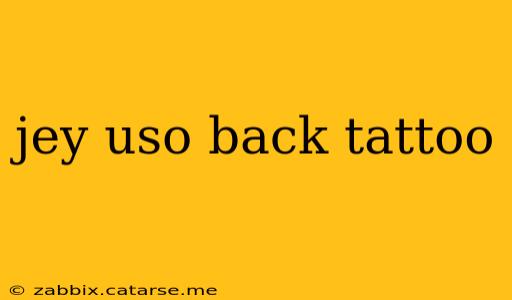Jey Uso, the celebrated WWE Superstar, is known not only for his electrifying in-ring performances but also for his striking back tattoo. This large-scale piece of body art is a powerful visual representation of his Samoan heritage, his deep family ties, and his strong faith. It's a complex and meaningful design that tells a story, much like the Uso family's incredible journey in professional wrestling.
While precise details and a complete photographic representation aren't readily available online (due to privacy reasons and the nature of the tattoo itself), we can explore what is publicly known and speculate on its potential symbolism based on Jey Uso's public persona and the common imagery associated with Samoan culture and faith.
What Does Jey Uso's Back Tattoo Depict?
Jey Uso's back tattoo isn't a simple design; it's a significant piece of artwork that likely incorporates several elements crucial to his identity. We can infer certain aspects with confidence:
-
Samoan Tribal Designs: Given Jey's Samoan heritage and the prevalence of traditional Samoan tatau (tattooing) within the Anoa'i family, it's highly probable his tattoo heavily features these intricate and symbolic designs. These tattoos aren't just decorative; they tell stories of lineage, family history, and personal achievements. Each element within the design likely carries specific meaning, passed down through generations.
-
Family Imagery: The Anoa'i family is a wrestling dynasty, and family is undeniably central to Jey Uso's life. It's likely his back tattoo incorporates symbols representing his family, perhaps including imagery related to his brothers, Jimmy Uso, and his extended family within the wrestling world. This could take the form of stylized designs or even portraits subtly integrated into the larger tribal pattern.
-
Religious Symbols: Faith plays a significant role in the lives of many Samoan people, and the Anoa'i family is no exception. Jey Uso's tattoo might therefore include Christian symbols or imagery representing his spirituality, subtly woven into the overall composition. This could be represented through subtle stylistic choices or the use of specific patterns often associated with Christian symbolism in Polynesian art.
What are the key elements found in Samoan Tattoos?
Samoan tattoos, or tatau, are far more than mere decorations. They are deeply significant cultural markers. Common elements include:
- Geometric Patterns: These are frequently used to symbolize strength, resilience, and family lineage.
- Animal Motifs: Animals like turtles, sharks, and eels often feature, representing various aspects of Samoan culture and beliefs.
- Floral Elements: Flowers are sometimes incorporated, often symbolizing beauty, growth, and spirituality.
How important is the family in Samoan culture?
Family is paramount in Samoan culture; it's a cornerstone of their societal structure. The emphasis on aiga (family) profoundly impacts all aspects of life, from everyday decisions to significant milestones. This close-knit family dynamic is evident in the Uso's success in the WWE, where their bond and shared heritage are consistently displayed.
Why is privacy surrounding Jey Uso's tattoo important?
Jey Uso, like many other celebrities, likely values the privacy of his personal life, including his body art. Tattoos are intensely personal statements, and his back tattoo's details might represent sensitive aspects of his history, beliefs, and family. Respecting his privacy regarding the exact composition of the tattoo is vital.
In conclusion, Jey Uso's back tattoo is likely a deeply personal and symbolic piece of art reflecting his Samoan heritage, his family, and his faith. While a complete visual representation isn't publicly available, understanding the significance of Samoan tatau and the Uso family's values allows us to appreciate the powerful statement it represents. The mystery surrounding the specific imagery only adds to its intrigue.
